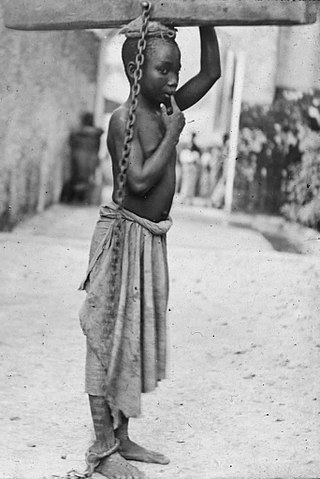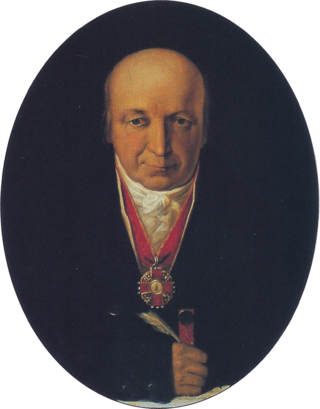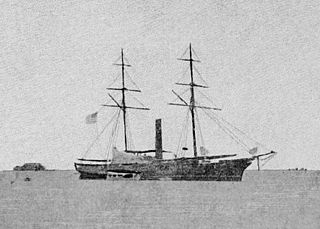Related Research Articles

Abolitionism, or the abolitionist movement, is the movement to end slavery and liberate slaves around the world.

The Tlingit or Lingít are Indigenous peoples of the Pacific Northwest Coast of North America and constitute two of the 231 federally recognized Tribes of Alaska. Although the majority, about 14,000 people, are Alaska Natives, there is a small minority, 2,110, who are Canadian First Nations.

From 1732 to 1867, the Russian Empire laid claim to northern Pacific Coast territories in the Americas. Russian colonial possessions in the Americas are collectively known as Russian America. It consisted mostly of present-day Alaska in the United States, but also included the outpost of Fort Ross in California, and three forts in Hawaii, including Russian Fort Elizabeth. Russian Creole settlements were concentrated in Alaska, including the capital, New Archangel, which is now Sitka.

Totem poles are monumental carvings found in western Canada and the northwestern United States. They are a type of Northwest Coast art, consisting of poles, posts or pillars, carved with symbols or figures. They are usually made from large trees, mostly western red cedar, by First Nations and Indigenous peoples of the Pacific Northwest Coast including northern Northwest Coast Haida, Tlingit, and Tsimshian communities in Southeast Alaska and British Columbia, Kwakwaka'wakw and Nuu-chah-nulth communities in southern British Columbia, and the Coast Salish communities in Washington and British Columbia.

Serfdom was the status of many peasants under feudalism, specifically relating to manorialism, and similar systems. It was a condition of debt bondage and indentured servitude with similarities to and differences from slavery. It developed during late antiquity and the Early Middle Ages in Europe and lasted in some countries until the mid-19th century.

Slavery in Canada includes historical practices of enslavement practised by both the First Nations until the latter half of the 19th century, and by colonists during the period of European colonization.

Alexander Andreyevich Baranov, sometimes spelled Aleksandr or Alexandr and Baranof, was a Russian trader and merchant, who worked for some time in Siberia. He was recruited by the Shelikhov-Golikov Company for trading in Russian America, beginning in 1790 with a five-year contract as manager of the outpost. He continued to serve past the end date of his contract.

The Kake War was the destruction in February, 1869, of three semi-permanent winter villages and two forts near present-day Kake, Alaska, by the USS Saginaw. Prior to the conflict, two white trappers were killed by the Kake in retribution for the death of two Kake departing Sitka village by canoe. Sitka was the site of a standoff between the Army and Tlingit due to the army demanding the surrender of chief Colchika who was involved in an altercation in Fort Sitka.

The term serf, in the sense of an unfree peasant of tsarist Russia, meant an unfree person who, unlike a slave, historically could be sold only together with the land to which they were "attached". However, this stopped being a requirement by the 19th century, and serfs were practically indistinguishable from slaves. Contemporary legal documents, such as Russkaya Pravda, distinguished several degrees of feudal dependency of peasants. While another form of slavery in Russia, kholopstvo, was ended by Peter I in 1723, the serfdom was abolished only by Alexander II's emancipation reform of 1861; nevertheless, in times past, the state allowed peasants to sue for release from serfdom under certain conditions, and also took measures against abuses of landlord power.

The Battle of Sitka was the last major armed conflict between Russians and Alaska Natives, and was initiated in response to the destruction of a Russian trading post two years before. The primary combatant groups were the Kiks.ádi Clan of Sheetʼká Xʼáatʼi of the Tlingit nation and agents of the Russian-American Company assisted by the Imperial Russian Navy.

Slavery in medieval Europe was widespread. Europe and North Africa were part of a highly interconnected trade network across the Mediterranean Sea, and this included slave trading. During the medieval period (500–1500), wartime captives were commonly forced into slavery. As European kingdoms transitioned to feudal societies, a different legal category of unfree persons—serfdom—began to replace slavery as the main economic and agricultural engine. Throughout medieval Europe, the perspectives and societal roles of enslaved peoples differed greatly, from some being restricted to agricultural labor to others being positioned as trusted political advisors.

Nora Marks Keixwnéi Dauenhauer was a Tlingit poet, short-story writer, and Tlingit language scholar from Alaska. She won an American Book Award for Russians in Tlingit America: The Battles of Sitka, 1802 And 1804. Nora was Alaska State Writer Laureate from 2012 - 2014.

Richard Dauenhauer was an American poet, linguist, and translator who married into, and subsequently became an expert on, the Tlingit nation of southeastern Alaska. He was married to the Tlingit poet and scholar Nora Marks Dauenhauer. With his wife and Lydia T. Black, he won an American Book Award for Russians in Tlingit America: The Battles of Sitka, 1802 And 1804. He has translated works into German, Russian, Finnish, and Classical Greek.

The history of the Tlingit includes pre- and post-contact events and stories. Tradition-based history involved creation stories, the Raven Cycle and other tangentially-related events during the mythic age when spirits transformed back and forth from animal to human and back, the migration story of arrival at Tlingit lands, and individual clan histories. More recent tales describe events near the time of the first contact with Europeans. European and American historical records come into play at that point; although modern Tlingit have access to those historical records, however, they maintain their own record of ancestors and events important to them against the background of a changing world.
Fort Stikine was a fur trade post and fortification in what is now the Alaska Panhandle, at the site of the present-day of Wrangell, Alaska. Originally built as the Redoubt San Dionisio or Redoubt Saint Dionysius in 1834, the site was transferred to the British-owned Hudson's Bay Company as part of a lease signed in the region in 1838, and renamed Fort Stikine when turned into a Hudson's Bay Company post in 1839. The post was closed and decommissioned by 1843 but the name remained for the large village of the Stikine people which had grown around it, becoming known as Shakesville in reference to its ruling Chief Shakes by the 1860s. With the Alaska Purchase of 1867, the fortification became occupied by the US Army and was renamed Fort Wrangel, a reference to Baron von Wrangel, who had been Governor of Russian America when the fort was founded. The site today is now part of the city of Wrangell.

Fort Tongass was a United States Army base on Tongass Island, in the southernmost Alaska Panhandle, located adjacent to the village of the group of Tlingit people on the east side of the island. Fort Tongass was the first US Army base established in Alaska following its purchase from the Russian Empire in 1867 and was garrisoned by the 2nd U.S. Artillery under the command of Captain Charles H. Peirce. Historian Hubert Howe Bancroft notes: "the site was well chosen, containing a plentiful supply of timber and pasture, while fish and game abound in the neighbourhood.

Baranof Island is an island in the northern Alexander Archipelago in the Alaska Panhandle, in Alaska. The name "Baranof" was given to the island in 1805 by Imperial Russian Navy captain U. F. Lisianski in honor of Alexander Andreyevich Baranov. It was called Sheet’-ká X'áat'l by the native Tlingit people. It is the smallest of the ABC islands of Alaska. The indigenous group native to the island, the Tlingit, named the island Shee Atika. Baranof island is home to a diverse ecosystem, which made it a prime location for the fur trading company, the Russian American Company. The Russian occupation of Baranof Island impacted not only the indigenous population and the ecology of the island, but also led to the United States' current ownership over the land.

While slavery has not been widespread on the territory of what is now Russia since the introduction of Christianity in the tenth century, serfdom in Russia, which was in many ways similar to contemporary slavery around the world, only ended in February 19th, 1861 when Russian Emperor Alexander II issued The Emancipation of the serfs in 1861. Emancipation of state-owned serfs occurred in 1866.
Serfdom has a long history that dates to ancient times.
Timofei Nikitich Tarakanov, also written Timofey Tarakanov, was born into serfdom in Kursk, Russia. His owner, Nikanor Ivanovich Pereverzev, sold him to the Russian-American Company (RAC) shortly after the company was created in 1799. He worked for the RAC in western North America and Hawaii from about 1800 to 1819. Tarakanov played an important role in the expansion of Russian operations south from Russian Alaska into Spanish California, usually as hunting party leader of indigenous sea otter hunters, mostly Aleut and Alutiiq people working for the RAC. This task often involved US maritime fur trade merchant ships transporting the hunting parties and their kayaks as far south as Baja California. Tarakanov played a key role in the founding of Fort Ross, California, and helped build and run Fort Elizabeth on Kauai in the Hawaiian Islands. He was granted manumission from serfdom and returned to his home near Kursk in 1819.
References
- ↑ "SHI Publishes Landmark Book on Slavery in Alaska That Endured After Federal Abolishment". Sealaska Heritage. Sealaska Heritage Institute Press Release. Retrieved 9 September 2024.
- ↑ Donald, Leland. Aboriginal Slavery on the Northwest Coast of North America. University of California Press. 1997
- ↑ Ruby, Robert H. Indian Slavery in the Pacific Northwest. Arthur H. Clark. 1993
- ↑ "In re Sah Quah". District Court of Alaska. 8 May 1886. Retrieved 29 Sep 2024.
- ↑ Bancroft, Hubert Howe (1886). Alaska 1730-1885. History of the Pacific States of North America. Vol. 28. San Francisco: A. L. Bancroft. p. 382. Retrieved 26 March 2021.
The [Russian-American Company] was allowed to engage all classes of free labor, and to employ serfs with the consent of their masters [...].
- ↑ Gwenn A. Miller (2005). "Russian Routes". Archived from the original on 2007-10-06. Retrieved 2007-11-18.
- ↑ Girl Slaves in Alaska; Principal of Territorial Schools Tells of Traffic. New York Times December 19, 1903
- ↑ SLAVES of the fur seal HARVEST, from the Cascadia Times; published Winter 2005; page 18-19.